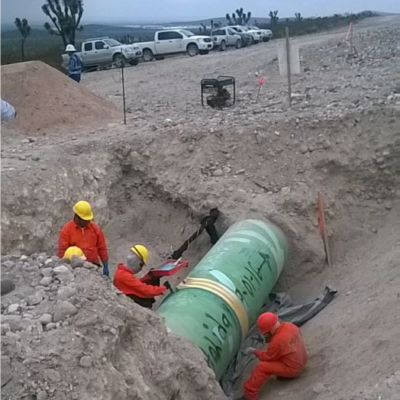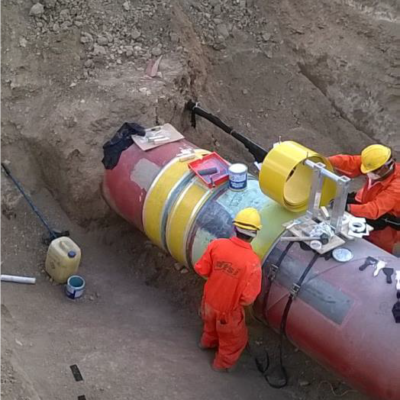Mexico
Pipe Details
- 42-inch (1,067-mm) pipe
- API 5L X70, 0.562-inch (14.3 mm) thickness
- 91 bar (1,320 psi) design pressure
- 30° C (86° F) maximum temperature
- 16-inch (406.4-mm) pipe
- API 5L X70, 0.219-inch (5.6 mm) thickness
- 91 bar (1,320 psi) design pressure
- 30° C (86° F) maximum temperature
- Coating: FBE 20 mils (508 µm)
- Wall Thinning during pipe manufacturing
Summary
- 18 Clock Spring composite sleeves installed on 42-inch (1,067-mm) and 16-inch (406.4-mm) wall-thinned pipe sections of a gas transmission system
- Installed marker bands on the transmission line to delineate the repaired area
- No hot work required
- The line remained in service during repair
- Local workers were trained to carry out Clock Spring installations
Discovering wall-thinned defects due to pipe manufacturing on a gas transmission line in Mexico, the owners needed an immediate fix that would not require the line to be taken out of service.
Following damage assessment by the CSNRI team, the decision was made to install 9 sections of 42-inch (1,067-mm) and 9 sections of 16-inch (406.4-mm) Clock Spring coils over segments of line that exhibited wall loss. Certified CSNRI technicians executed the repair, and in the process, trained the operator’s employees on proper installation methods.
Using the coil pass as well as the spool feeder technique to contend with limited clearance underneath the large diameter line, the repair team installed each coil in less than 45 minutes, completing the installation without taking the line out of service.
While the repair itself was important to the company, it also is important to be able to identify the repaired area during future maintenance inspections and to be able to use the repaired locations as reference points on the buried pipeline should future pipeline excavations be required.


Following the application of the Clock Spring sleeves, marker bands were applied to the start and finish points of the overall repair using a simple installation technique. These marker bands provide a signature reference and are identified by a Magnetic Flux Leakage (MFL) intelligent pig during future in-line inspections performed within the pipeline.
With all the sleeves installed and the markers properly positioned, the repaired section of pipe was cured for two hours. An operator-approved corrosion coating was applied over the complete repair area, and the line backfilled.

